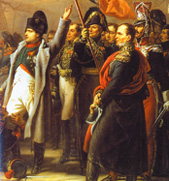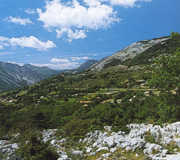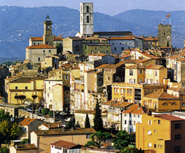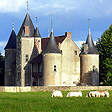ROUTE NAPOLEON - N85
Scenic Drive Road from Mediterranian to French Alps
 On
March 1st of 1815, Napoleon Bonaparte landed on a white
sandy beach on France's southern shore of
the Mediterranean from 10 months exile on the Island of Elba with a rag-tag
fleet of seven boats and 1,200 loyal soldiers. The people of France
were
dissatisfied
with
King Louis XVIII, and Louis had stopped paying the annual 2 million
Francs the former Emperor had accepted for his "retirement stipend".
Within a week, faster than news could travel, the returned Emperor
Napoleon
and his
men marched across the French Alps to Grenoble, then to Paris. The little
colonel now returned Emperor ruled for another 100 days before
his final defeat at Waterloo after reinvading Belgium (See Waterloo).
On
March 1st of 1815, Napoleon Bonaparte landed on a white
sandy beach on France's southern shore of
the Mediterranean from 10 months exile on the Island of Elba with a rag-tag
fleet of seven boats and 1,200 loyal soldiers. The people of France
were
dissatisfied
with
King Louis XVIII, and Louis had stopped paying the annual 2 million
Francs the former Emperor had accepted for his "retirement stipend".
Within a week, faster than news could travel, the returned Emperor
Napoleon
and his
men marched across the French Alps to Grenoble, then to Paris. The little
colonel now returned Emperor ruled for another 100 days before
his final defeat at Waterloo after reinvading Belgium (See Waterloo).
 The
road from the French coast to Grenoble followed by the returning
warrior king and his men is now
famously known as the Route Napoleon or Napoleon road.
French national road N85. It was designated the Route Napoleon as a
scenic
touring road
in 1932. The primary highway through the French Alps from Italy would
be closed for much of the winter, so a lower route was designated. The
Route Napolean runs from Golfe Juan, the sandy cove where Napoleon placed
his boot after returning from Elba, through Cannes, Grasse, Castellane,
Sisteron and Gap to Grenoble. Parts of the road
are windy
and
twisty, but all of it is quite beautiful.
Rocky crags, slopping hillsides covered with flowers, snowcapped peaks
in the near distance close enough to touch. A section outside of Grasse
provides a panoramic view from the hills to the French
Riviera
coast.
After
Castellane
the
road
winds
through
the Natural Park of the Gorges of Verdon, the “Grand Canyon” of
France. Between Sisteron and Gernoble the Alps are every present, but
the road stays low enough to travel through a chain of beautiful towns
and villages.
The
road from the French coast to Grenoble followed by the returning
warrior king and his men is now
famously known as the Route Napoleon or Napoleon road.
French national road N85. It was designated the Route Napoleon as a
scenic
touring road
in 1932. The primary highway through the French Alps from Italy would
be closed for much of the winter, so a lower route was designated. The
Route Napolean runs from Golfe Juan, the sandy cove where Napoleon placed
his boot after returning from Elba, through Cannes, Grasse, Castellane,
Sisteron and Gap to Grenoble. Parts of the road
are windy
and
twisty, but all of it is quite beautiful.
Rocky crags, slopping hillsides covered with flowers, snowcapped peaks
in the near distance close enough to touch. A section outside of Grasse
provides a panoramic view from the hills to the French
Riviera
coast.
After
Castellane
the
road
winds
through
the Natural Park of the Gorges of Verdon, the “Grand Canyon” of
France. Between Sisteron and Gernoble the Alps are every present, but
the road stays low enough to travel through a chain of beautiful towns
and villages.
Golfe Juan, where the route begins is a less visited spot on the French Riviera, one SCNF stop from Cannes. Pablo Picasso was a long time resident of Golfe Juan and the National Picasso Museum is located in the Renaissance era Castle of Vallarius. Golfe Juan and Vallarius are the same city connected by a narrow valley. Vallarius is known for its ceramics and the Ceramics Museum is also in the Castle museum.
 Cannes is
of course known for its Film Festival (see Cannes
Festival on a Budget) but is a year around
glamour destination
on the French Riviera with its
grandd hotels on the “Crosette”, gleaming harbor of yachts
and white beaches of topless sunbathers. Grasse is known for its perfumes.
Perfume began in the 16th Century in Grasse with a scented glove to cover
the smells of growing cities. Grasse, with its hillside
of flowers became a center of perfume production (see Fragonard), with
small streets lined with pink houses
and wrought iron balconies, the Villa Fragonard and the International
Perfume Museum. Castellane lies
underneath the Notre Dame du Roc, a church high on an impossible mountain
cliff
(see Notre
Dame du Roc). Digne-les-Bains has been
known since Roman times for its pure air and water and recognized as
the lavender
capital of the world. Sisteron is nestled between
the ramparts of the ancient city guarding the rocky pass and marks the
boundary between Provence and the Dauphine regions.
The magnificent French fairy tale Castle favorite of the Dauphin (heir
to the throne when they still had them) Chateau Vizelle was
once the southern residence of French Presidents and now houses the
Museum of the French Revolution. Grenoble is
perhaps best known for hosting the winter Olympics in 1968 with Jean-
Claude
Killy, but is the undisputed capital of the French Alps at the joining
of the
Drac
and
Isere Rivers and a popular ski town.
Cannes is
of course known for its Film Festival (see Cannes
Festival on a Budget) but is a year around
glamour destination
on the French Riviera with its
grandd hotels on the “Crosette”, gleaming harbor of yachts
and white beaches of topless sunbathers. Grasse is known for its perfumes.
Perfume began in the 16th Century in Grasse with a scented glove to cover
the smells of growing cities. Grasse, with its hillside
of flowers became a center of perfume production (see Fragonard), with
small streets lined with pink houses
and wrought iron balconies, the Villa Fragonard and the International
Perfume Museum. Castellane lies
underneath the Notre Dame du Roc, a church high on an impossible mountain
cliff
(see Notre
Dame du Roc). Digne-les-Bains has been
known since Roman times for its pure air and water and recognized as
the lavender
capital of the world. Sisteron is nestled between
the ramparts of the ancient city guarding the rocky pass and marks the
boundary between Provence and the Dauphine regions.
The magnificent French fairy tale Castle favorite of the Dauphin (heir
to the throne when they still had them) Chateau Vizelle was
once the southern residence of French Presidents and now houses the
Museum of the French Revolution. Grenoble is
perhaps best known for hosting the winter Olympics in 1968 with Jean-
Claude
Killy, but is the undisputed capital of the French Alps at the joining
of the
Drac
and
Isere Rivers and a popular ski town.
The Napoleon Road can be followed from the South where it begins or can be intersected from Aix-en-Provence or Avignon and followed either north to Grenoble or south to the Cote d'Azure with many little towns and villages to visit for a croissant and glass of wine, and a number of markers along the way commemorating the steps of Napoleon's march. You don't have to take the week it took the Emperor and his soldiers. The route can be driven in about 8 hours but plan to make a stop-over or a few days to enjoy it. A day trip can alo be made from the coast up to Castellane then over to Aix-en-Provence and back. © Bargain Travel Europe
Compare best hotel and travel deals Cote d'Azur - Provence
Web
Info
Route Napoleon
See Also:
FAMILY ENTERTAINMENT ON THE COTE d'AZURE
ROMAN
THEATER ANTIQUE ORANGE
CHATILLON-SUR-SEINE


